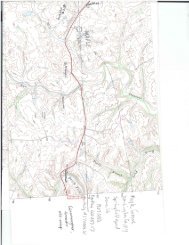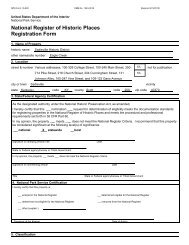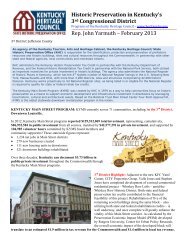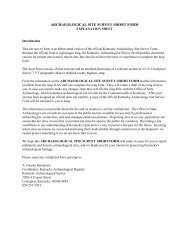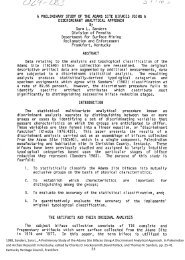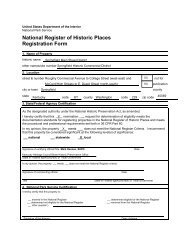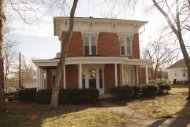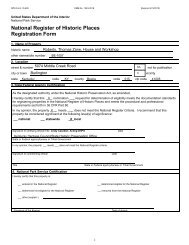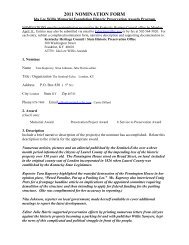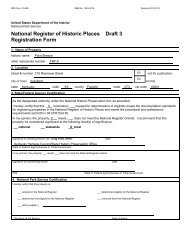John J. Walton House - Kentucky: Heritage Council
John J. Walton House - Kentucky: Heritage Council
John J. Walton House - Kentucky: Heritage Council
You also want an ePaper? Increase the reach of your titles
YUMPU automatically turns print PDFs into web optimized ePapers that Google loves.
meaning as a civilizing force. (This is demonstrated by the popularity of “restoring” log buildings by stripping awayweatherboarding and plaster to reveal the bare logs beneath: a practice that would have puzzled the original owners.) Assummarized by Henry Glassie:Vacationing folks escape to the woods to forget the city, to relax, to get burned by the sun, bitten by bugs,perhaps to find something like a god in nature. Rolling up logs to build a fancy camp, the city sport leaves themround and brown. They still resemble trees, each distinct in the wall and knobby with knots, and he lets themweather to silver to fit his notion of the natural. A part of nature, his vacation home also alludes to history, to thelog cabin that stands firmly in the American consciousness as a mythic sign of the time of the beginning. But thelog cabin’s builder went into the woods to establish civilization.The wilderness howled around him, sublime and vast and threatening. He chopped into it bravely, felling trees,hewing their faces flat, lifting them into plumb alignment, and trimming their ends flush at the corner…. Thetrees of the forest were attacked, hacked, split, and made to submit to the plan in his head…. He built to makethe world better, to secure a place of control and reason within the madness of the wilderness. A man of culture,he built a farmhouse that stood out of the woods in splendid artifice… The timber embedded in the frame or thebrick in the wall are not reminders of nature but pieces of plans and proofs of human control. (Glassie 2000: 34)On its ridgetop, the <strong>Walton</strong> <strong>House</strong> stands as a cultural artifact, a practical, sturdy and efficient house, versatile andadaptable, well buffered against the elements. Easily expanded, it could be incorporated into a larger house, recycled asan outbuilding, or dismantled and salvaged. The log home of mid-19 th -century Boone County was no longer the pioneershelter to be abandoned in a generation, but the home of an upwardly mobile farmer, to be home to generations of thesame family.Evaluation of the Architectural Significance of the <strong>Walton</strong> <strong>House</strong> within its Historic ContextThe <strong>Walton</strong> <strong>House</strong> is seen as important because of its stacked, single-pen form in the context of Boone County ruralvernacular architecture. Until the post-Civil War era, much of the county’s population lived in one- and two-roomdwellings, including single-pen, hall-and-parlor, double-pen and saddlebag dwellings. Although such houses areconsidered small by 21 st -century standards, Boone County census and tax research show that these modest dwellingswere home not only to small landholders on marginal, rocky, hill farms, but to middling and prosperous farmers withextensive acreage, large crops, and numerous livestock, such as the previously mentioned Jonas Clore farm.By these standards, the <strong>Walton</strong> <strong>House</strong>, with two pens and a double-pile ell, would have been considered a comfortablerural dwelling of the mid-19 th century. The addition of the second pen, which would have required considerable effort andadditional expense to construct, may indicate the owner’s desire not only for more living space, but for more differentiatedspace. The two-story plan would have provided a clearer separation between the more public space of the first floor, forcooking and light household production, and the second-floor private space for sleeping. It is a distinctive and intriguingvariation on a more common rural vernacular house type.Integrity ConsiderationsIntegrity is defined as the ability of a property to convey its significance in its material form. With this building’ssignificance a product of seeing its form as important, then integrity factors have been selected which reinforce that viewof significance. Of the seven components of integrity, the most critical to conveying the significance of the <strong>Walton</strong> <strong>House</strong>are location, setting, design, feeling and association. The <strong>Walton</strong> <strong>House</strong> retains enough of these defining characteristicsto be readily identified as an example of the two-story, single-pen house type.The <strong>Walton</strong> <strong>House</strong> has integrity of location because it has not been moved. The <strong>Walton</strong> family had large land holdings inthe western Boone County uplands, above the Ohio River. The 168-acre <strong>John</strong> D. <strong>Walton</strong> Farm was one of several familyproperties in the vicinity of Burlington and Belleview precincts. The house survives as the primary residence on a largefarmstead that has not been subdivided or converted to other uses. With this building in its original location, therelationship between the buildings and the land has tangible form.The <strong>Walton</strong> <strong>House</strong> has integrity of setting because it remains in a rural locale. It remains surrounded by pasture, with abarn, a corncrib, and domestic dependencies nearby. Though not nominated in its entirety, the farm remains more or lessintact and undisturbed by construction of buildings since the mid-20 th -century. No new structures have been built on theproperty since then, apart from a power line under construction at the bottom of the hill, which is not visible from thehouse.8



